- Conditionally
- Newsletter Signup
All products are independently selected by our editors. If you buy something, we may earn an affiliate commission.

10 Pro Tips To Make Your Long Commute Not Suck
By Christopher Post

About three months ago, I started to make a three-hour round-trip commute to work five days a week. I drive through upstate New York on an empty freeway, so it’s scenic and smooth—but it's still a commute, and it's still five days a week. Now that I've gotten used to it, I'm realizing there are some things that would have made life so much easier if I'd known them from day one. Here are 10 of the most important ones.
1. There’s a podcast for anything and everything.
Are you into board games? There's a podcast for that. Are you into true crime stories? There's a podcast for that. Are you into sports, but you wish analysts were a tad more intellectual? There's a podcast for that, too.
2. Siri makes a great DJ.
The new Siri is amazing when combined with Apple Music and the Apple Watch. All you have to do is say, “Hey Siri, play...” and she'll handle the rest. Want to know what the number one song was the day you were born? Just ask, because Siri has got that shizz on standby. Honestly, it's been as much fun experimenting with different music commands as it has been listening to the results. BTW, my birthday song is "Jump" ** by Van Halen.
3. Lumbar support is a non-negotiable when you drive so much.
About a month into my new commute, I started experiencing excruciating pain in my back and right leg. Turns out I'd slipped a disc. Did the commute cause it to slip? Maybe. Did the commute slip it quicker? Probably. My physical therapist recommended a lumbar roll, which is a firm pillow that you wedge between your lower back and the seat of the car. It forces you into much better posture , which helps to relieve the pain. I carry mine around like a kid with his favorite stuffy. You can pick up a cheap lumbar support on Amazon , or even roll up a towel for a makeshift version.
4. Long commutes come with legit fuel rewards.
I enrolled in a gas station rewards program, so now I get two points for every dollar I spend on fuel, food, or whatever. I also save five cents a gallon for every $100 I spend, which isn't much, but it’s something. There are even several credit cards, gas station and otherwise, that offer as much as 3 percent cash back on fuel purchases.
5. It’s all about the cruise control.
This won't work for everyone's commute, but like I said, mine is on a usually empty freeway. Cruise control reduces my driving fatigue and keeps me from getting nabbed by the popo.

Paramount Pictures / via Tumblr
6. ESPN streams all of their live radio programming.
I am a walking encyclopedia of football knowledge—both college and pro—all thanks to ESPN Radio. About a month after my commute started, and a few days after my subscription to Sirius XM ran out, I discovered that ESPN’s live radio programming is free to stream on a smartphone. Now I spend my mornings with "Mike & Mike."
7. I need to make my own coffee.
SMH, that sh*t is expensive.
8. The GPS app Waze is bae.
Waze, powered by Google, goes beyond just giving you directions. It actually changes your route in real-time if it can get you to your destination quicker. Waze is driven (pardon the pun) by user-generated data, which means that if I'm in a traffic jam, it will recognize the slowdown and automatically send that data to other users. Since you can also self-report construction zones, road hazards, and inclement weather, Waze has helped me avoid some serious delays. And the best part? You can report speed traps!
9. Maintaining a car costs a lot of money.
I've never put this kind of stress on a car before. Three hours a day for five days a week is tough on my car, and I'm up to 260,000 miles and counting. Just last week I had to drop a mint on new tires. Word of advice: if you're signing up for a long commute, work repairs and regular maintenance into your budget .
10. Music-Map.com is a thing.
I inevitably get bored with "Mike & Mike" and the infinite amount of podcasts available, so some days I turn to music to get through my commute. However, I'm a finicky consumer. Sometimes I get sick of that one album by that one artist, but want to listen to something similar. With Music-Map.com , you type in the name of an artist and get a scatterplot of sorts. In the center is the artist you chose, and the artists surrounding the center point are musically similar. The closer the peripheral artists are to the central artist, the more alike they are. Music-Map.com made it easy to jump from Grimes to Purity Ring to Crystal Castles in three easy steps, meaning there's always something new to jam to.
ITV / via Tumblr
Photo Credit: Mike Vasilyev / Unsplash
SELF does not provide medical advice, diagnosis, or treatment. Any information published on this website or by this brand is not intended as a substitute for medical advice, and you should not take any action before consulting with a healthcare professional.


Enter your search term
Search by title or post keyword
What is the Average US Commute in 2023?
Average commute per state, how long of a commute is too long, making the best out of your commute, methodology, average us commute: how much waste commuting in your lifetime (by city).

Since 2012, Brett Helling has built expertise in the rideshare and delivery sectors, working with major platforms like Uber, Lyft, and DoorDash.
He acquired Ridester.com in 2014, the first ridesharing marketplace, leveraging his direct experience to enhance the site. His insights at Ridester are recognized by Forbes, Vice, and CNBC.
Expanding his reach, Brett founded Gigworker.com and authored “ Gigworker: Independent Work and the State of the Gig Economy “, demonstrating his comprehensive knowledge of the gig economy.
More about Brett | How we publish content
What Happened to the Killer From Michigan That Killed an Uber Partner?
The true cost of commuting in the united states [explained], the most recent doordash lawsuits in 2023 and what they mean.

Key Takeaways
- The average US commute time is 52.2 minutes per day, with some states facing over 100 hours lost per year due to congestion.
- The longest commutes are found in California, New York, and Pennsylvania, influenced by dense populations and congested cities.
- States like North Dakota, South Dakota, and Wyoming enjoy the shortest commutes due to less traffic and closer living and working locations.
- Over a lifetime, Americans spend an average of 408 days commuting, with the trend towards longer commutes potentially affecting sleep, productivity, and quality of life.
For a growing number of people, it is becoming more difficult to endure the average US commute.
It is no wonder why there is an ever-growing list of ridesharing companies that have completely revolutionized the model of car-sharing .
It can be particularly frustrating when a commuter has no choice but to sit in traffic because of congestion, housing preferences, or sheer distance alone.
Whatever the contributing factors are, America is seeing a consistent increase in average commute time.
What this portion of the population knows all too well is that a long commute can negatively affect the sleep habits, productivity, and quality of life of American workers, it can also induce road rage .
However, not all states or cities are experiencing these changes equally.
Find out the average US commute by state, and which have the worst commute and which have the shortest commute.
What does your commute mean for the environment?
Find out with our interactive car polution map .
In short, the cost of commuting is huge.
The average US commute time is 52.2 minutes a day commuting to and from work, but in many parts of the country, things are even worse.
Over the course of just a week, that’s 4.35 hours a week spent commuting .
According to the Inrix Global Scorecard , US states with the longest commutes hav e lost over 100 hours per year with over $1,500 per driver expended due to congestion .
This figure, calculated by the Census Bureau, indicates that this 2019 commuter data is steadily increasing from previous records.
Projecting this figure over years and decades becomes even more astounding.
While an increase of a few minutes over a few years or between states might not seem like a drastic change, these increments multiply into losses in productivity in the big picture.
The financial impact of traffic on residents of a city can be as simple as wasted gas or as intricate as delayed transportation workers raising housing costs.
That got us thinking — how many days does the average person spend commuting to and from work over the course of their life?
We did the math for nearly 1,000 US cities.
The average American loses 408 days of their life commuting, and in many areas, the toll is even higher.
Interactive Map By City and State
Using the interactive map below, you can see how many days of your life you can expect to be in the car.
How to Use the Interactive Average US Commute Map
The above map is interactive and easy to use.
If you want to see commute times in your area, simply click the pin icon on the upper-left corner of the map, and it will zoom into your city (assuming you aren’t using a VPN).
You can also click the magnifying glass to search by city name if you don’t want to use your IP location.
From there, simply click on the nearest dot on the map and you’ll see data on that area’s average daily round trip commute time in minutes as well as the total number of days you can expect to spend commuting over your career.
One note for mobile users — you may find the map tool displays better if you flip your device to display horizontally.
So, are you rethinking your commute yet?
States with the longest commute
If you live in or near a densely populated city, you know from experience that this is where much of the country’s congestion lies.
With astronomical populations, many jobs, and popular routes, it is no wonder that the densest cities produce the longest commutes.
Here are the longest-commuting states:
- Pennsylvania
Whether workers are navigating within a city or traveling to and from a hot spot, the transit times quickly add up.
California suffers from long commute times because of its numerous congested cities such as Los Angeles and San Francisco.
Pennsylvania, on the other hand, sees longer commutes due to the more spread out housing community like East Stroudsburg and congested cities like Philadelphia.
States with the shortest commute
Short commute times are an advantage that may be due to proximal living and working locations or lighter traffic.
Depending on the type of job the population holds, they could be more prone to living on-site, closer to work, or driving on open roads.
Here are the states with the shortest commutes:
- North Dakota
- South Dakota
These sprawling and slow-paced states offer great benefits to workers who don’t want to waste their days on a commute.
When the US Census started collecting data on daily commutes in 1980, the average time it took for citizens to travel to work was 21.7 minutes .
Over three decades, that average shifted up a staggering 20 percent.
In 2016, the average commute was 26 minutes.
Yet, the portion of commutes which were 45 minutes or longer is growing steadily to a solid 17% compared to only 12% of the 1980 population traveling for 45 minutes or more.
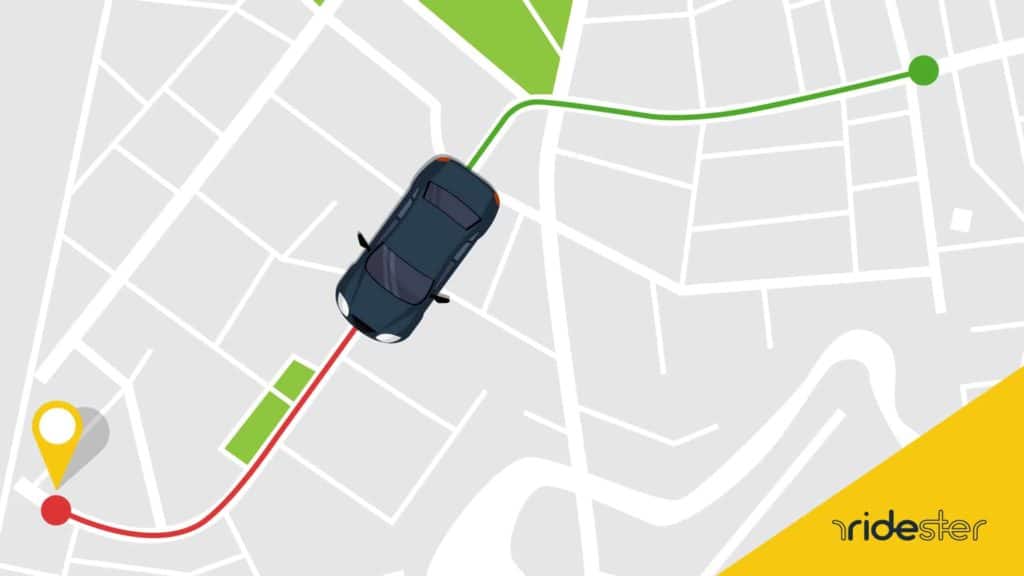
The concern lies in a steady increase in commute times.
With more and more time in the day being lost to traveling, it seems like the effect on productivity and even sleep can only be negative.
As we all know, there is no time to spare on this growing problem.
While the recent lockdown procedures between 2020 and 2023 significantly decreased traffic in even the most high-traffic areas, this lull would not last forever.
Already, many areas have returned or surpassed the pre-Covid levels to indicate that the problem of growing commutes is not gone yet.
Considering the effects longer commutes have on workers’ sleep habits, productivity, and quality of life, this is an issue that will continue to grow more concerning, especially as many have tasted the freedom of easier drives and remote working during the pandemic.
Though we all hope to see reform and improvements in the tortuous daily commutes, we can still make the best of our lot until quicker and more efficient methods are introduced.
Perhaps the best remedy to the curse of a long drive is to transform your attitude about it.
Here are some ways that you can take back control of your day and enjoy your drive even when it is longer than you’d prefer:
- Queue up a new podcast or audiobook to listen to on the road. Engaging your mind and your ears is a safe and productive way to spend the extra time.
- Use this quiet time in the morning and night to pray or meditate. Reflecting and processing through your day can take away the stress of the moment and get you ready to hit the ground running.
- Look into getting a car with great gas mileage . This will save you money in the long run, even if you don’t think it will.
- With hands-free technology readily available, ask your device to call a friend or family member to have a low-key chat during your commute.
- Ask around to carpool with local coworkers. The extra company and sustainable driving will instantly improve the trip.
You can also get creative and get paid for car advertising , turning those dead miles into cash.
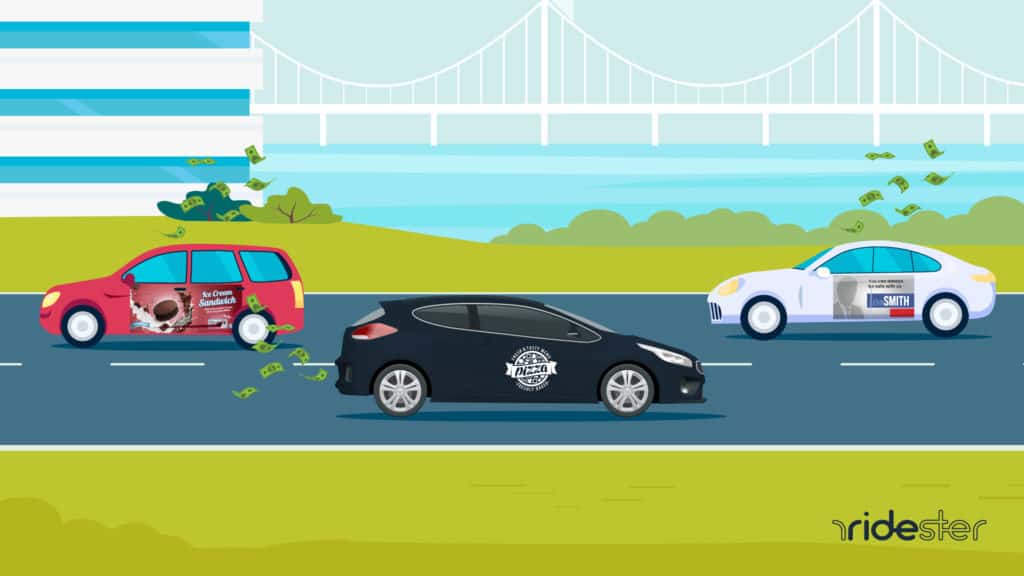
Car wrap companies like Wrapify or Carvertise will pay you to wrap your car and drive around, giving valuable exposure to brands looking to expand.
The irritation of congested commutes arises in all Americans who have woes of wasted time, lost sleep, and stressful driving.
While there is no simple solution to these large-scale problems, awareness and acceptance can provide at least short-term relief from this frustrating reality.
If you are considering moving to one of these traffic hotspots, be sure to investigate your driving routes and how they may affect the environment and your mental health.
But in the meantime, adopt some of these tips to make the drive more enjoyable.
And don’t forget to use a mileage tracker app to track your miles, potentially saving you money during tax time!
Happy driving!
So, how did we calculate the number of days you can expect to spend commuting in your life in each city?
For the purposes of this study, we assumed the average person starts full-time work at 18 (some people start earlier, others a bit later).
We also know the average retirement age is 63 in the United States .
That’s 45 years of working a full-time job.
We then worked from the assumption that most people work about 250 days per year, which accounts for 2 weeks annual vacation and time off.
That’s 11,250 days of working/commuting over a career.
From here, we simply used data from the US Census Bureau on average daily roundtrip commute times for nearly 1,000 cities and towns across the country and then did the math.
Credit for creation of the map goes to: Leaflet | qgis2web Map tiles by Stamen Design , under CC BY 3.0 . Data by OpenStreetMap , under ODbL .
1 thought on “Average US Commute: How Much Waste Commuting in Your Lifetime (by City)”
Hello Brett! I am currently writing a research paper on a similar topic; I was wondering if you could possibly share your data set with me? It would be very helpful.
Leave a Comment Cancel reply
Save my name, email, and website in this browser for the next time I comment.
Related Posts
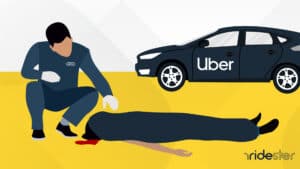
Browse our Resources
Whether you're a customer or a driver, we've made it easy to find information about how to make the most of rideshare, delivery, and transportation companies.
New to #ridesharing and #delivery? Start here!
Get all the best information about the Delivery Industry.
Explore Delivery Service companies and jobs.
Income & Payments
Find the best advice on using delivery services as a customer.
Gig Economy Knowledge from Experts

Why I enjoy my 5-hour super commute
My commute to work takes over five hours round trip. in my sixth letter to my son, i wrote about why i genuinely enjoy my super commute..

When I tell people that my commute takes over five hours round trip, most responses are similar:
“That’s rough!”
My least favorite response was from an arrogant, young “professional” that I had literally met minutes earlier for networking purposes:
“You’re crazy, man!”
My favorite response, by far, was from a coworker that always brings great energy:
“Dude, that’s so savage.”
For two years, I have commuted from Yolo County to San Francisco for work. Despite the ludicrous distance from our home to my work, I accepted the job because of the salary and company. The first few months were rough, but eventually, I started to actually ENJOY my commute!
Below is a breakdown of my one-way commute. I arrive to the Davis train station twenty minutes early to secure a free parking spot. I spend over half of my commute on an Amtrak train, and another chunk on a shuttle chartered by Amtrak. The shuttle drops me off near my work in San Francisco.
I enjoy my commute in large part thanks to the awesomeness of Amtrak. Throughout this letter, I praise Amtrak and crap on alternate methods of transportation. In other words, this letter is basically free advertising for Amtrak.
Of course, my commute isn’t all sunshine and rainbows. There are a few aspects of my commute that would be deal breakers to a lot of people.
In this letter, I break down why I enjoy my five-hour commute, and the unpleasantries that come with it.
I don’t have to drive for long
A few months before I started my current job, I received an offer for a job in Walnut Creek. Had I accepted the job, I would’ve had to drive for an hour to get to work. The commute would have been miserable compared to my current commute because to me, driving sucks compared to train travel.
Obviously, you can’t sleep while driving. This may change (where you at, Elon?), but for now, you can’t catch up on Zs while at the wheel.
You can’t stand up or stretch while driving. Had I taken that other job, I would probably be dealing with nagging back soreness and racking up chiropractor bills.
You can’t read, work, or mess around on the Internet while driving. Well, you could, but you would be needlessly putting yourself and others in danger.
My commute consists of a small amount of driving to get to the train station, but it’s not bad. I essentially zoom down a traffic-less, country road.
Some people do enjoy long drives. The last thing I want to do before and after work is battle traffic and avoid lunatics on the road.
I don’t have to deal with non-train public transportation
Most public transportation, though practical and affordable, is unpleasant to take.
I’m going to rip on Bay Area Rapid Transit (BART) because it’s what I would probably take if I lived close to work.
BART is to public transportation in northern California as downtown Honolulu is to Oahu . During commute hours, BART is a cesspool. Ask anyone that commutes on BART, and they’ll probably be able to recall stories that involved urine, feces, vomit, yelling, fighting, PDA, and other things that can put a damper on a commute.
BART train cars are literally packed with people during commute hours. The result is an ongoing jockeying for space. There is a high likelihood that you will touch / brush up against people during your trip. As I’ll touch on later (pun intended), you don’t have to deal with any of this crap on Amtrak!
Unless you’re a senior, cripple […bastard, or a broken thing…] , securing a seat on BART during commute hours is a challenge. It’s easier near the ends of the lines, but otherwise, you’ll have to be aggressive to swoop on vacated seats. All I’m saying is that you don’t have to play this game on Amtrak!
I must note that Caltrain (public transportation in Silicon Valley ) holds a special place in my heart. I rode Caltrain on the night that your mom and I met for the first time! I’ll tell you the story someday, but for now, I’ll just say that a huge pro [or con, depending on how you look at it] of Caltrain is that alcohol consumption is allowed.
Amtrak is delightful
According to Amtrak.com , in 1970, the United States Congress passed the Rail Passenger Service Act, which established Amtrak to take over the intercity rail service. Today, Amtrak’s annual ridership exceeds 30 million passengers, and Amtrak serves more than 500 communities nationwide.
Over the past two years, I’ve come to love Amtrak. Besides private jet or a first class flight, I cannot think of a more enjoyable way to travel.
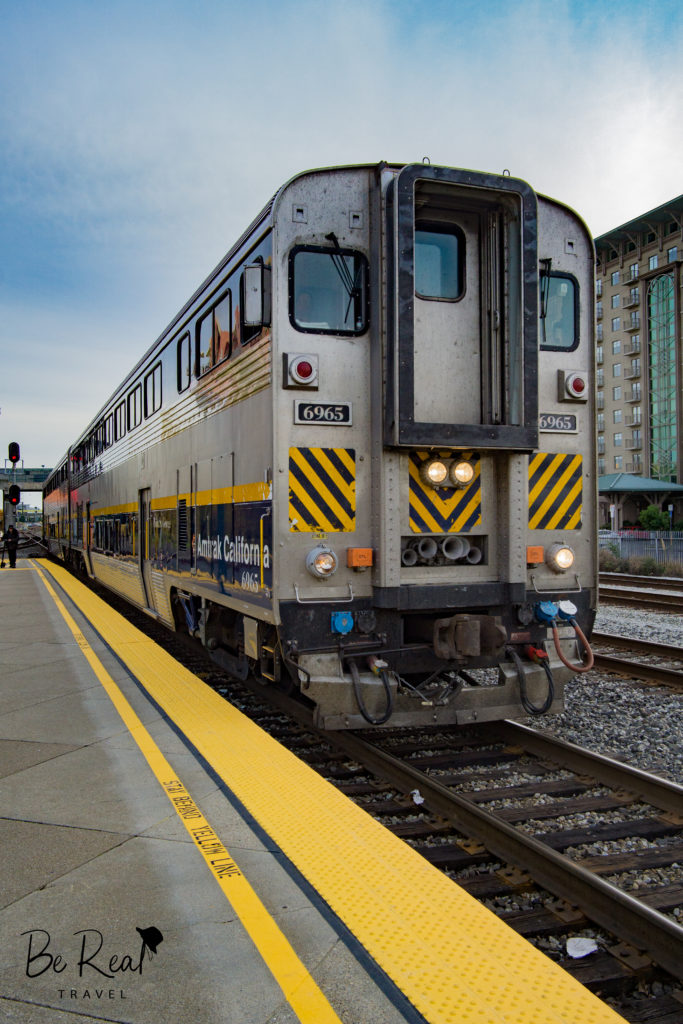
I rarely have to sit next to someone on my Amtrak train home. Compared to your BARTs and subways of the world, the seats are comfortable and offer a respectable recline angle. Also, each seat has access to an electrical outlet to keep those devices chugging.
Amtrak boasts WiFi connectivity. BART and Caltrain do not ( at least not yet ). It’s a game changer to be able to connect my laptop to the Internet. No hotspot needed!
Amtrak has bathrooms, so the train never reeks of urine like other forms of public transportation sometimes do. It’s nice to have that bathroom fallback option to avoid having to stressfully hold it, pee [or defecate?] in a bottle, or pull a Billy Madison .
From my experience, there is limited riffraff on Amtrak for a couple of reasons. Unlike most other forms of public transportation, Amtrak is not cheap. Let’s be real; the relatively high Amtrak prices go a long way in weeding out shady characters. It also helps that Amtrak staff scans tickets and hangs markers indicating that a passenger has paid. If you don’t have a ticket, authorities are summoned to escort you off of the train. Time between stops is significantly higher on Amtrak (15 to 30 minutes) than many other forms of public transportation (a few minutes). It’s not easy for seedy characters to sneak onto the train and hop off at the next stop without paying.
Finally, Amtrak has a cafe car! On the train, you can purchase food, drinks, and ALCOHOLIC BEVERAGES.
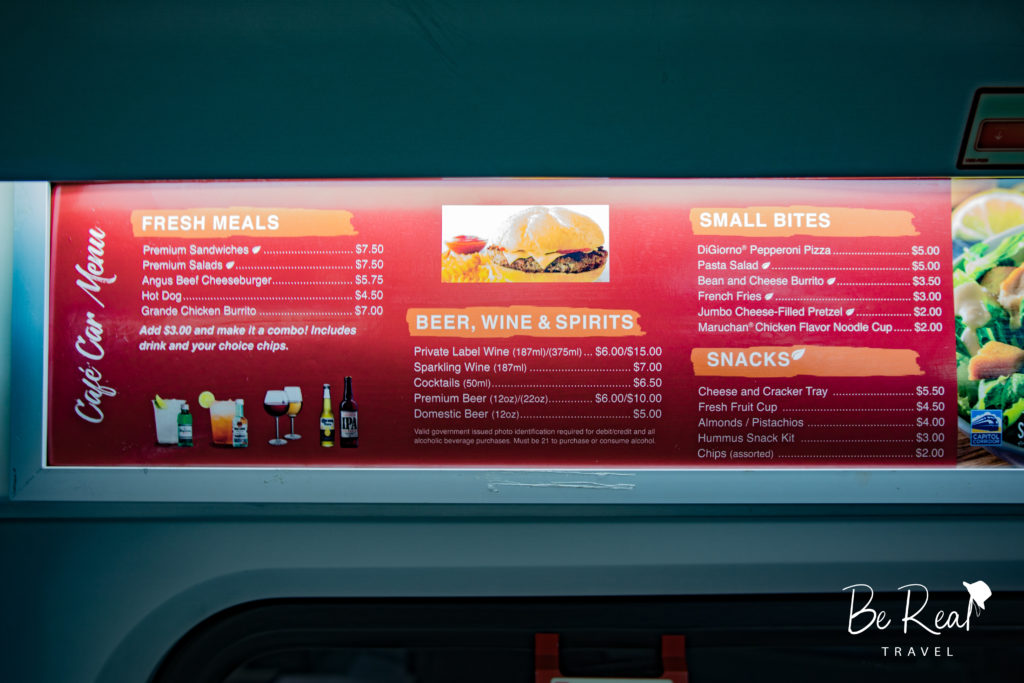
I can do almost anything that I want on Amtrak
Here is a sample of things that I can do on Amtrak that I wouldn’t be able to do [at least not safely] while driving:
- Sleep, work, read a book
- Shop, order dinner, read the news
- Watch TV, movies, sports
- Post process photos
- Write letters about travel to you
- Watch videos that your mom sends me of your latest shenanigans
- Google Hangout with you
I’m one of those people that derives an exorbitant amount of pleasure from crossing things off of my to-do list. Needless to say, I live my best life on Amtrak.
I can sleep comfortably on Amtrak
One of the best things about my commute is that I can comfortably catch up on my sleep. On average, I sleep for about 1 to 1.5 hours during my commute. Typically, I take two naps (calling it a “nap” makes it sound so childish, but hey, IT IS WHAT IT IS) during my commute: on the train to work in the morning, and on the shuttle from work in the afternoon.
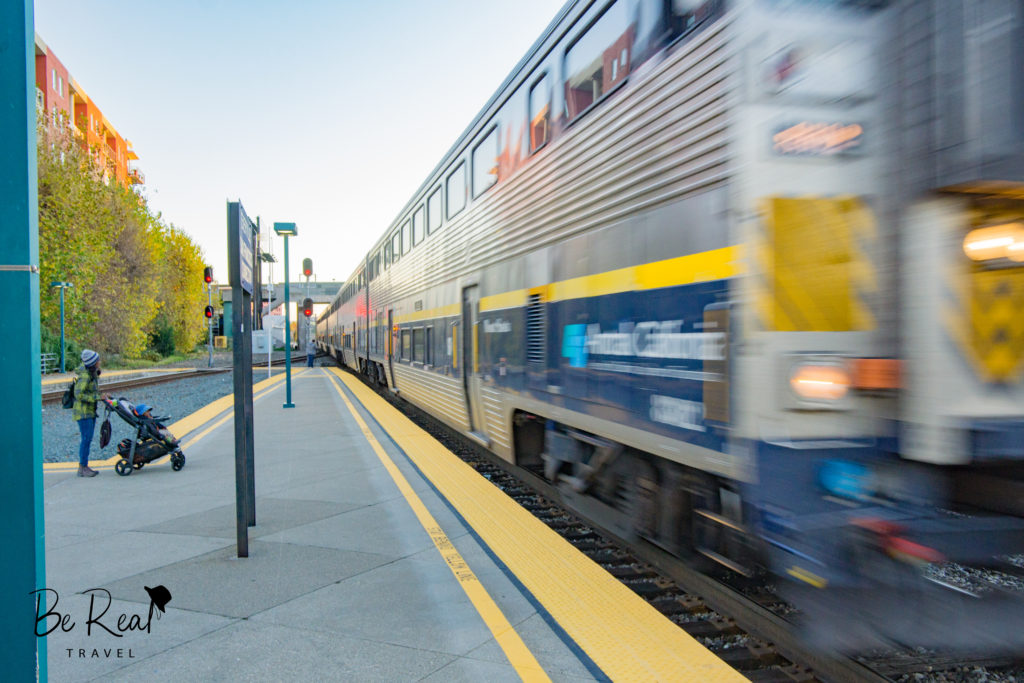
There are a number of reasons why I sleep soundly on Amtrak. First, every train has a designated quiet car, an oasis for sleep-seeking commuters. In the quiet car, making any kind of noise is prohibited. Also, overhead lighting is dim in the quiet car. The result is a dark, tranquil ambiance conducive to sleeping.
Watch out, Amazon rainforest – you have some competition for best sleep-inducing white noise in the world! The train’s hodgepodge of noise elements , in conjunction with the movement of the train, rock me right to sleep.
As I mentioned earlier, Amtrak seats provide comfort through an adequate recline angle and amount of leg space.
My train ride is long enough so that I never worry about suffering from one of those crappy, short naps that make you feel groggy. My naps on Amtrak leave me feeling refreshed and rejuvenated.
Also, I never worry about waking up to an “Oh crap, I missed my stop!” moment. My body has been conditioned to wake up a few stops before I have to get off of the train.
There is one non-Amtrak related reason why I sleep so well on the train. I’m sleep deprived because I’m the father of a baby! Hey, don’t take this as me blaming you for being sleep deprived; take this as me thanking you for helping me sleep so well during my commute.
On the shuttle after work, I often slip into a deep sleep. I’m guaranteed a seat, the cabin is usually quiet, and the seats recline even further than they do on the train. After a mentally-exhausting workday, I hop on the shuttle, throw in my earbuds, and knock the F out .
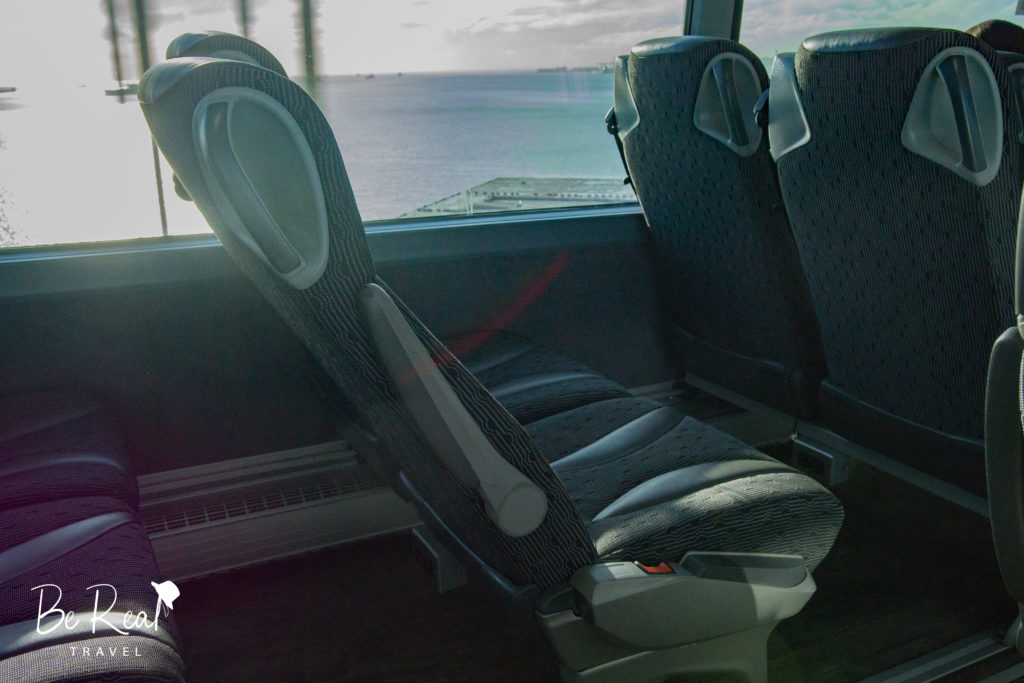
Speaking of measures that I take to optimize my commute naps; take notes, kid – Here are some of my keys to success:
- Wear: noise-cancelling earbuds, sunglasses, multiple layers
- Sit: in the quiet car, away from the stairs, where the overhead lights shine the least, next to a window with the shades drawn
- Sit next to someone: already asleep (if I see an open seat next to someone wearing an eye mask and covered in a blanket, it’s a done deal), not hogging more space than they should, not brandishing a light-polluting device
I have missed my shuttle stop once. If you’re not interested in reading about this baffling incident, skip the next few paragraphs.
One day after work, I grabbed a few cocktails with coworkers. Upon boarding the shuttle, I was feeling the buzz. The shuttle was packed, but I secured a seat in about the fourth row. I fell asleep almost immediately.
When I woke up, the bus was moving and empty except for the driver and me. Panicked, I spoke up, “Hey, I think I missed my stop.”
The bus driver replied, “Yup…I’m not driving back though.”
Luckily, we were close to my stop, so I got out, walked, and still made it onto my train.
There are multiple things about this incident that baffle me:
- Upon exiting the shuttle’s only door, and considering that the shuttle only has one stop, why didn’t one of the 50+ passengers that walked by my sleeping ass wake me up?
- Why didn’t any of my fellow dozen-or-so shuttle regulars recognize that my sleeping ass was a fellow regular and wake me up?
- Why didn’t the shuttle driver, before departing from our only stop, look behind him and notice that there was a can’t-miss-black-haired-Filipino man passed out just a few rows behind him and wake me up before departing?
- What happened to my lunch box and water bottle? I had both items upon boarding the shuttle. When I woke up, both were gone (fortunately, my backpack with my laptop was still with me).
The only possible explanation is that people did try to wake me up, but were unsuccessful so thought, “Oh well, he ain’t waking up,” and moved on.
All I know is that somewhere out there, someone is enjoying my CamelBak water bottle (which your Lola and Opa gifted to me!) that features the name of my hometown (Petaluma) inside the red outline of a chicken .
A bunch of other good stuff
- “Me time” to decompress – My primary goal during my commute is to arrive home with zero baggage. I nap so that I arrive home energized, work so that I don’t have to crack open my laptop at home, and relax so that I can fully exert myself during your bedtime routine. When I get home, my sole focus is to be the best father and husband that I can be.
- I get the best of both worlds – Up in the Sacramento valley (where we currently live), salaries, cost of living, and real estate are significantly lower than down in the San Francisco Bay Area. My commute enables me to reap the best of both worlds: that Bay Area salary and that valley cost of living. By the way, remind me to tell you about the time that I sang a line from The Artist Formerly Known as Hannah Montana’s hit song on a stage in front of hundreds of people.
- I only commute a few times per week – I’m fortunate that my job affords me the flexibility to work from home often. If I had to commute every day, I probably would’ve quit my job by now and I sure as hell wouldn’t be writing this letter. Being able to break up my commute and early wake-up days is HUGE.
- The views aren’t too shabby – Throughout my commute, I’m treated to picturesque views. I would definitely enjoy my commute less if I was commuting through somewhere depressing like the dreary world in my favorite Alfonso Cuarón movie Children of Men .

- Train travel is good for the environment – I trust that Amtrak’s infographic is telling the truth about the eco-friendliness of my commute.
It’s a TREK of a commute
Five hours is a long-ass time. That’s ~60% of a good night’s sleep, ~20% of an entire day, and ~3% of an entire WEEK.
In the time that my commute takes, I could watch five episodes of Game of Thrones , seven episodes of LOST , or fourteen episodes of The Office .
There’s no getting around it; from a length perspective, my commute is monstrous .
I spend less time with you and your mom
If your mom and I could, we would spend every waking hour with you. Every minute that I spend commuting in a minute less that I spend with you.
Technology helps us stay connected throughout the day, but there is no substitute for being with each other in person.
On commute days, it sucks that I only get to hang out with you for a few hours in the evening. I do spend a lot more time with you on work-from-home days, plus all day with you on the weekends.
Delays aren’t uncommon
Amtrak can be delayed for reasons that include mechanical issues, railroad congestion, and trespasser incidents . Amtrak publishes performance reports , but they don’t provide much detail. I estimate that 70% of my trains have been on time, 20% delayed by up to 10 minutes, and 10% delayed over 10 minutes.
A majority of my delays occurred at Emeryville station. Emeryville isn’t a bad place to be stranded. The station has ample seating, decent bathrooms, and a Subway Sandwiches across the street. I usually use any delay that lasts for over thirty minutes as an excuse to crush a sandwich and chips for dinner (with a cookie if I’m feeling especially wronged by the delay) while I wait for my train.
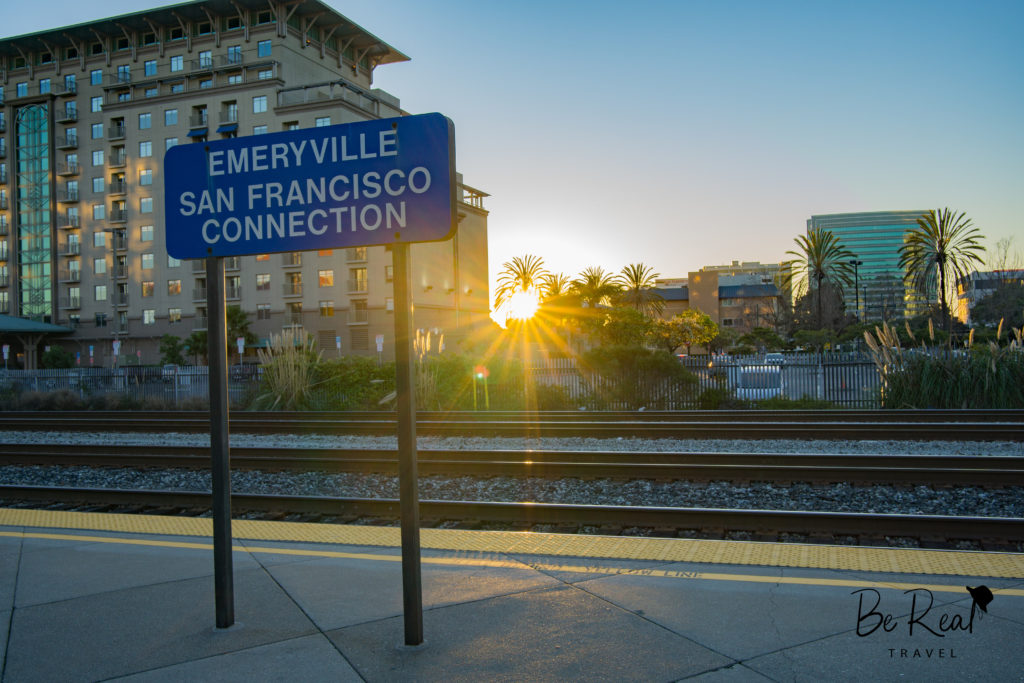
The longest Amtrak delay that I’ve experienced is 3.5 hours. On the evening of that delay, I had slammed a couple of beers for a work team event. While on the train home, my team-event-boosted morale was crushed when the train stopped and I heard the dreaded announcement from our conductor, “There has been a trespasser incident, so we’re going to be here for a while. We’ll let you know when we have more details.”
Trespasser incidents that involve a fatality usually last hours. Getting the train moving again is dependent on multiple parties (e.g. police, fire department, coroner) surveying and documenting the scene. This particular delay was complicated further because it happened after hours and in an isolated location. Amtrak staff didn’t provide us an estimate on when the coroner would arrive until over two hours into the delay!
The crappiness of the delay was compounded by my post-buzz headache and the fact that the cafe car doesn’t sell Advil. I didn’t arrive home until 2am, so I didn’t get to play with you before you went to bed.
Extended delays are inherently egregious, but in a weird way, this experience actually encapsulated my love for Amtrak. I wasn’t sitting next to anyone. The cafe car was giving out free bottles of water. WiFi on the train still worked. I had packed my laptop charger. The time flew as I hammered out some work, shopped for Christmas presents, conducted in-depth fantasy football analysis, and worked on a letter for a certain first-born son of mine. Also, I didn’t have to wake up early the next day because I work from home on Fridays.
If I ever got stuck on Amtrak for 37 hours , I would probably destroy this letter and wage a personal vendetta against Amtrak for the rest of my life. Honestly though, it might not be all that bad, provided that the WiFi was working, the temperatures weren’t extreme, and the cafe car had enough food and water to dole out. The bathroom situation would be abysmal though.
A bunch of other bad stuff
- I have to catch the train early – It’s all relative (your Lola and Opa regularly wake up at like 3am), but waking up to catch the early train can be painful (especially after having my sleep interrupted multiple times throughout the night by your crying butt!).
- I live by Amtrak’s schedule – When I lived in Hawaii , I walked to work. When I lived in San Diego, I drove to work. In both cases, I basically left for and from work whenever I wanted. With Amtrak, I have to catch a train or shuttle at a precise time; otherwise, I have to wait forty minutes for the next one.
- Amtrak WiFi is spotty – WiFi on Amtrak might be the MVP of my commute. As a nitpick though, the connection isn’t always reliable. I learned quickly not to schedule work calls while on the train (“Can you hear me now? What was that? Sorry about that, we just went through a tunnel…”). The connectivity is solid as the train gets up into the valley. It can be frustrating down in the bay when more of my fellow super commuters are chewing up bandwidth.
- People are annoying – This is pretty much applicable to life in general, but here are Amtrak-specific examples that I need to share:
The person that disturbs everyone in the quiet car – The worst offender that I can remember of the “Shut the F up” quiet car policy is a woman that walked the entire length of the quiet car while speaking loudly on her phone. Through her ignorance, she woke up dozens of people within seconds.
The person that puts their belongings on the seat next to them – “One ticket, one seat” is a policy that Amtrak staff regularly reminds passengers about over the loudspeaker. Nonetheless, people still [childishly] violate the policy in an attempt to decrease the chances of / make it more awkward for a fellow commuter to sit next to them.
The person that doesn’t wait for people in front of them to get off of the shuttle first – Everyone has somewhere to be, and you would think that it would be common sense to let others seated in rows in front of you get off of the shuttle before you do. Alas, there are neanderthals that, after the shuttle stops, immediately get up and push forward towards the exit, showing little regard for the passengers seated in front of them.
The person that stinks – Compared to your BARTs and subways of the world, I’m proud of my fellow Amtrak super commuters for excelling in the “take a damn shower and don’t apply too much fragrance” competency. Once in a while though, you do get that one person that screws the pooch and ruins existence for everyone sitting within a twenty foot radius.
The person that prevents people from parking in front of or behind them – Free parking at the Davis Amtrak station is limited. The last few spots to fill are parallel parking. Occasionally, people selfishly space their parking so that another car cannot fit in front of or behind them. Kid, don’t be like one of these jabronis that cause one more person to have to have to pay $5 at a parking lot located a ten-minute walk away from the station.
- Amtrak ain’t cheap – With Amtrak, you get what you pay for – An experience that is vastly superior to other forms of public transportation for a premium price. In 2020, a 10-ride Amtrak ticket from Davis to San Francisco costs $200, or $40 per round trip. My salary makes up for the cost of my train passes, but, if instead of taking Amtrak, I drove to Richmond and took BART the rest of the way (i.e. commuted through hell), I would save a bunch of money.
- Happy hour is disruptive – In past jobs where I had an “un-super” commute, it was easy to grab a drink with colleagues after work and be home by a reasonable time. This isn’t the case with my current commute. If I go out to happy hour, I won’t get home until after 8pm, which is after your current bedtime.
- Amtrak climate control isn’t perfect – There are times on Amtrak when I’ve felt as cold as I did in the frigid, end-of-winter Great Smoky Mountains , and there are times when I’ve sweated my ass off like I was in the sticky, humid Amazon Rainforest .
- I can’t exercise during my commute – Hook me up with a [ safe ] way to burn calories during my commute, Amtrak! I’m kidding of course, but a guy can dream.
THE BOTTOM LINE
Many people dread their commute. I look forward to my commute as an opportunity to sleep and get stuff done.
Thanks to Amtrak, I’m comfortably able to do pretty much anything that I want (except exercise…).
While I enjoy my commute, I concede that it’s not for everyone. You would probably hate my commute if:
- Your bed is the only place where you sleep well
- Salaries and cost of living are higher where you live than where you work
- You’re single and looking to mingle
- You’re a happy hour enthusiast
- You would rather be stuck in traffic
- You would rather be rubbing elbows with strangers where there is limited seating, no WiFi, no bathrooms, and no car that serves food and alcohol

As much as I enjoy my commute, realistically, I probably won’t keep doing it long term. Eventually, you’ll have school and extracurricular activities that I cannot miss. Until then, I’ll continue to live it up on my super commute.
P.S. While I worked on this letter, you learned to walk in your walker and we celebrated your first new year! As I write this sentence, I’m sitting on an Amtrak train, eager to get home and play with you. Coincidentally, your mom sent me a video of you laughing at your mobile literally seconds before I started writing this sentence, then called me via Google Hangout to show me. On the call, you promptly stopped laughing because that’s the kind of little rascal that you are!
Copyright 2020 | Be Real Travel | Powered by Photocrati

By the end of 2024, 90% of companies will require a return to the office, be it hybrid or full-time. With more employees returning to the office, commute times are reaching pre-pandemic levels . Considering rising fuel costs and burgeoning traffic congestion, Americans are left wondering how long it will take them to get to work and at what cost.
Using data from the U.S. Census, we looked at the average commute time to work (in minutes) for car and public transit commuters in 100 of the largest U.S. cities to find where commutes are the longest and shortest around the country. In addition to the time cost of commuting, we calculated the financial cost of car and public transit commuting in each city to find where commutes are the most and least expensive.
So what does commuting truly cost, in both time and money? Read on for the full breakdown.
The Average Commute Time to Work by Car
The average American car commuter will spend 25.4 minutes per day commuting to work and 50.8 minutes round-trip. That equates to nearly 19 hours of commuting time each month, nine days of commuting time each year, and over a year of commuting time throughout one’s working lifetime.
Here are the U.S. cities with the longest car commutes to work:
- Riverside, CA – 32.6 minutes
- Stockton, CA – 32.5 minutes
- Washington, D.C. – 31.7 minutes
- Atlanta, GA & New York, NY – 30.7 minutes
- Poughkeepsie, NY – 30.6 minutes
Riverside, CA, Stockton, CA, Washington D.C., Atlanta, GA, and New York, NY have the longest car commutes—each over a half-hour one-way and over an hour round-trip. Within those five cities, New York City commute times increased by 4.07% year over year, while Washington D.C. commute times increased by 3.26%.
Here are the U.S. cities with the shortest car commutes to work:
- Wichita, KS – 20.0 minutes
- Omaha, NE – 20.4 minutes
- Provo, UT – 20.8 minutes
- Toledo, OH – 20.9 minutes
- Rochester, NY – 21.1 minutes
Wichita, KS, Omaha, NE, Provo, UT, Toledo, OH, and Rochester, NY have the shortest car commutes –– all under 22 minutes one-way and under 43 minutes round-trip. Within those five cities, Toledo, OH commute times decreased by 2.34% year over year, while Provo, UT commute times decreased by 1.89%.
Sarasota, FL, Tampa, FL, Harrisburg, PA, Spokane, WA, and Colorado Springs, CO saw the largest increases in commute times year over year—all over 6%. Springfield, MA, Baton Rouge, LA, Jackson, MS, Ogden, UT, and Toledo, OH saw the largest decreases in commute time year over year—all over 2%.
The Average Commute Time to Work by Public Transit
The average American public transit commuter will spend 44.6 minutes per day commuting to work and 89.2 minutes round-trip (almost an hour and a half). That amounts to 33 hours of commuting each month, 16 days of commuting each year, and over two years of commuting time throughout one’s working lifetime.
Here are the U.S. cities with the longest public transit commutes to work:
- Memphis, TN – 88.5 minutes
- Poughkeepsie, NY – 86.0 minutes
- Stockton, CA – 85.1 minutes
- Bridgeport, CT – 71.1 minutes
- New Haven, CT – 63.7 minutes
Memphis, TN, Poughkeepsie, NY, Stockton, CA, Bridgeport, CT, and New Haven, CT have the longest public transit commutes –– each over two hours round-trip. Memphis public transit commuters, in particular, will save over two hours each day commuting by car versus public transit.
Poughkeepsie, NY and Stockton, CA stand out on the list of top five cities for having both the longest car and public transit commutes, signaling that getting around in these cities is generally a time-consuming affair.
Here are the U.S. cities with the shortest public transit commutes to work:
- McAllen, TX – 22.3 minutes
- Augusta, GA & Omaha, NE – 23.9 minutes
- Greenville, SC – 24.8 minutes
- Birmingham, AL – 24.9 minutes
- Greensboro, NC – 27.4 minutes
McAllen, TX, Omaha, NE, Augusta, GA, Greenville, SC, and Birmingham, AL have the shortest public transit commutes—all under 28 minutes one-way and under 55 minutes round-trip. Out of the 100 cities analyzed, public transit is faster than car commuting by a small margin in three cities: Augusta, GA, Birmingham, AL, and Greenville, SC.
The Financial Cost of Car Commuting to Work
68.7% of Americans commute to work alone in a vehicle each day. And personal commute costs like fuel, maintenance, and insurance can really start to accumulate for drivers with long commute distances. On average, U.S. car commuters will spend $170 on commuting each month and $2,043 on commuting each year.
Nine out of the ten most expensive cities for car commuting are located in Florida due to longer commutes, above-average gas prices, and high car insurance premiums in the state. Miami, FL is the most expensive city for car commuting, with an annual commute cost of $2,656. Daytona Beach, Fort Myers, Lakeland, Sarasota, and Tampa follow closely behind, all with annual car commute costs over $2,600.
With annual commute costs under $1,500, Boise, ID, Dayton, OH, and Cleveland, OH are the three least expensive cities for car commuting due to shorter commute distances and relatively low car insurance premiums.

The Financial Cost of Public Transit Commuting to Work
Public transportation commuting rose from 2.5% to 3.1% between 2021 and 2022. Nearly 50% of public transit commuters in the U.S. take the bus to work, but in larger metro areas, over a third (37%) rely on rapid transit services like a metro or subway to get to their jobs.
Of the larger cities with multiple modes of public transit, New York City is the most expensive city for public transit commuting, with an annual commute cost of $1,584 . NYC’s monthly subway pass increased from $127 to $132 in 2023.
Proving to be a pricey commuting city all around, Miami is not only the most expensive city for car commuting but also the second-most expensive city for public transit commuting, with annual commuting costs of $1,350. West Coast cities Portland, OR, Sacramento, CA, and Seattle, WA round out the top five most expensive cities for public transit, all with annual commuting costs over $1,000.
Of the larger cities with multiple modes of public transit, Houston, TX and Orlando, FL are the most affordable cities for public transit commuting, with annual commute costs of just $567 and $672 , respectively . Houston commuters can save $1,483 each year using public transit instead of driving, while Orlando commuters can save a whopping $1,969.
Of the smaller U.S. cities relying primarily on bus service, Memphis, TN and Boise, ID are the two least expensive, with annual commute costs ranging from $300-$325. In these areas, monthly bus passes are affordably priced between $25 and $27.
Time vs. Money: Commuting Tradeoffs

The daily commute presents a balancing act between time and financial considerations. Choosing between driving and using public transit can significantly impact both your schedule and wallet. Here’s what the tradeoffs look like in real numbers.
Opting for car commuting over public transit can gift you back an average of 38 minutes each day . This time saved adds up quickly, equating to roughly 14 hours each month or an entire year over the span of a lifetime .
However, the financial aspect of commuting paints a different picture. The average American bus commuter spends $600 annually. Taking the bus can save commuters over $120 per month and $1,412 per year. The average U.S. public transit commuter who uses rapid transit services like metro, subway, or light rail spends $976 on commuting each year. While higher than the bus-exclusive cost, it still presents savings of $1,036 annually when compared to car commuting.
The decision between car and public transit commuting ultimately hinges on individual priorities and circumstances. For some, the time saved by car commuting is invaluable, offering flexibility and more personal time. For others, the financial savings and environmental benefits of public transit align more closely with their values and budgetary constraints.
Closing Thoughts
It’s clear that both time and money play pivotal roles in determining the most efficient and cost-effective ways to navigate our daily trek to work. For car commuters, managing and mitigating the associated costs becomes crucial. This is where Coast fuel cards enter the equation, offering a strategic advantage. Using these cards, commuters and businesses alike can significantly reduce their transportation expenses through discounts, rewards, and detailed expense tracking .
Methodology
To find the time cost of commuting around the U.S., we found the mean commute time to work (in minutes) for both car and public transit commuting in the 100 largest U.S. metro areas using the most recent data from the U.S. Census American Community Survey (ACS). We then extended this data to daily, monthly, annual, and lifetime figures, with lifetime indicating 47 working years (i.e., the average retirement age of 65 minus 18 years old).
To find the total financial cost of car commuting in the same metro areas, we found the average commute mileage to work and used that as a starting point to calculate gas, maintenance, and insurance costs on a daily, monthly, and annual basis. We sourced data on average commuting distances from StreetLight Data , gas and maintenance costs from AAA , car insurance costs from Policygenius , and fuel economy data from the Environmental Protection Agency (EPA) .
To find the financial cost of public transit commuting in each metro area, we found the cost of a monthly transit pass using data from APTA’s public transit fare database and local transit authority websites. Using the monthly pass costs, we could determine the annual cost of public transit commuting in both large metro areas, which have bus and rapid transit services (metro, subway, light rail), and smaller metro areas, which have primarily bus service.
Drive your fleet with Coast
Get up and running in just a few simple steps.

What is a Reasonable Commute Time and Distance to Work in 2024?
Unless you are working from home , you will probably need to commute to work.
- The average one-way commute time to work in the United States has increased to 27.6 minutes now, up from 26.1 minutes in 2016 and 25.1 minutes 10 years ago.
- 1 in 4 workers left their job stating commuting is their main reason to quit .
- 25% of workers do not commute to work.
Commuting to work is common for most employees, and traveling long distances to your job each day is not uncommon.
Millions of workers spend hours each day commuting to work.
“But how long of a commute is considered to be reasonable?”
What Is A Reasonable Commute To Work?
A reasonable commute to work is determined by two factors; time and distance. The commute to work should be less than 50 miles and within 30 minutes, where the commuting area from your home to the workplace should be within the area of intended employment.
Nonetheless, a reasonable commute to work sometimes varies between individuals and circumstances.
How long is a reasonable commute time to work?
The commute time to work should be at least 5 minutes long, and ideally, the one-way commute time should be more than 16 minutes.
According to our recent survey, the commute of 20 to 30 minutes to work is generally considered to be a reasonable commute time.
How long is a reasonable distance to commute to work?
A reasonable commute distance to work should be less than 50 miles and the commute will preferably be less than 5 straight lines.
But a good commuting distance to work is highly determined by a variety of circumstances such as the geographical landscape or traveling conditions from your home to your workplace.
What Is An Average Commute To Work?
An average commute to work is 27.6 minutes. The commute to work can be defined as the distance someone travels to get from their home to their place of employment. 1 in 3 workers in the United States spends 15 minutes to 29 minutes commuting to work each way.
The variation is huge as there are a number of factors that can affect this number. Commuting times vary based on where someone lives, the type of transportation they use, and the time of day they travel.

How long is the average commute time to work
An average American spends less than 1-hour round-trip commuting for work.
On average, 94% of all workers in the U.S. spend 27.6 minutes to commute each way to work and travel for an average of 18.8 miles to work each way.
With a 5 days work week, the time spent on commuting for average commuters is calculated.
- Average commuters spend 4.6 hours per week and 239.2 hours per year commuting.
- Average commuters spend more than 1 week, which is 9.97 days per year traveling to and back from their workplace.
How long is the average commute distance to work?
On average, 9 in 10 American workers commute 18.8 miles to work each way.
With a 5 days work week, the distance traveled for commuting to work for average commuters is calculated.
- Average commuters travel 188 miles per week and 9,776 miles per year commuting to work.
- Average commuters travel a distance equal to 3,309 football fields per week and travel a distance equal to two-fifth of the Earth per year commuting to work.
How Long Of A Commute Is Too Long?
Commutes that are longer than 45 minutes are considered long. With a 5 days work week, you will spend 7.5 hours per week and 390 hours per year commuting. Which is equivalent to 16.25 days of traveling to and back from your workplace.
HQHIRE did an analysis of the study performed by the Census Bureau on 75.746 million workers in the United States, to understand what percentage of our workers perform a commute that is longer than reasonable.
- Extreme commuting account for 2.26% of all workers who travel 90 minutes or more commuting to work each way.
- Long-distance commuting accounts for 2.96% of all workers who travel more than 50 miles or more commuting to work each way.
- Mega commuting accounts for 0.77% of all workers who spend more than 90 minutes and travel for more than 50 miles to work.
Studies have shown, that there is a rise of “super” commuters from 1990 to date:
1 in 36 workers spent more than 90 minutes commuting each way to work.
With a 5 days work week, the time spent on commuting for extreme commuters is calculated.
- Extreme commuters spend 15 hours per week and 780 hours per year commuting.
- Extreme commuters spend more than 1 month, which is 32.5 days per year traveling to and back from their workplace.
The longer the commute, the lesser time you’ll have for your family, friends, social life, exercise, and self-care.
Why long commute is bad?
Employees who require to have a long commute for a prolonged period of time will negatively impact their physical and mental health , environment, and work productivity.
- Physical Health . You do not have time to exercise as you’ve spent most of your time traveling, thus poorer cardiovascular health.
- Social Health . You reduce your time spent socializing, which can lead to loneliness and depression.
- Mental Health . You feel more stress due to the unpredictability of traffic events while you are rushing to work.
- Environmental Impact . You travel longer, thus contributing more to environmental pollution.
- Work Productivity Impact . You spend most of your time stressing about your commute, which leaves you with less energy dealing with your work, thus reducing your productivity at work.
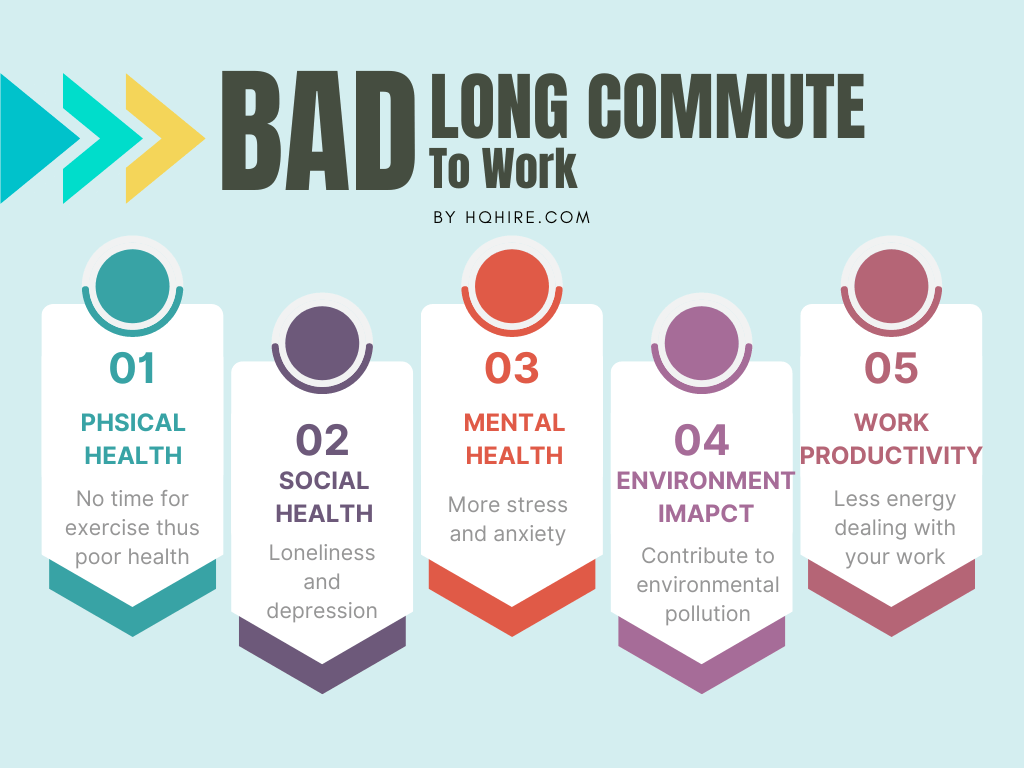
Average Commute Time By Different States in The U.S.
The average commute time for each of the states in the United States is compiled and calculated to give you an understanding of where you stand on your commute to work each day.
The state with the longest commute time to work is found to be New York, with an average of 33.3 minutes of one-way commute to work.
With a 5 days work week, the time spent by an average New Yorker on commuting is calculated.
- Average commuters spend 5.6 hours per week and 288.6 hours per year commuting.
- Average commuters spend almost 2 weeks traveling, which is 12 days per year traveling to and back from their workplace.
The state with the shortest commute time to work is found to be South Dakota, with an average of just 17.0 minutes for a one-way commute to work.
With a 5 days work week, the time spent by an average worker living in South Dakota on commuting is calculated.
- Average commuters spend 2.8 hours per week and 147.3 hours per year commuting.
- Average commuters spend less than a week traveling, which is just 6.1 days per year traveling to and back from their workplace.
The State you are living in the U.S. can determine how much time you spend traveling to and back from work.
- The State with the shortest average commute to work is “South Dakota”, with a one-way commute time of only 17.0 minutes, and 6.1 days per year traveling to and back from work.
- The State with the longest average commute to work is “New York”, with a one-way commute time of 33.3 minutes, and 12 days per year traveling to and back from work.
Depending on which state you live in, you can spend just half the time traveling to work, and more time with your family.

How does the urbanization rate affect the commute time of the high and low-income groups?
Increased urbanization rate of the Metropolitan areas can lead to an increase in the average commute time of the higher-income group but lowers the commute time for the lower-income group.
- High Income Group . Urbanization leads to more cars and transport traveling on the road which leads to slower traffic and thus increases the commute time for the higher-income group.
- Low Income Group . Urbanization allows workers of lower-income groups to be accessible to public transport for commuting to work, thus reducing the commute time for the lower-income groups.
How is commute time affected in a densely populated area?
States or cities with a population higher than the rest will require the workers to take a longer commute to work.
Living in an densely populated area can lead to an increase in commute time as well as non-motorised transport use.
A study on the average travel time to work by Metropolitan Area population size shows, that areas with more than 5 million people living will need an average of 33.1 minutes to travel to work, compared to areas with a population of less than 300,000 where it will only need 22.6 minutes to travel.
The difference in the amount of time you travel to work is huge, depending on where you work, you can save up to 7.5 minutes on traveling to work each way.
And if you are living in South Dakota, with an average commute to work of 17.0 minutes, you can potentially save 16.1 minutes each day.
How to make your time commuting worthwhile?
For most workers, commuting to work is unavoidable, unless you are working from home, or doing your work remotely.
Sitting in traffic, or stuck on the train can be frustrating, but you can utilize ways to maximize your time spend on your traveling.
Here are some suggestions:
- Take an online course
- Learn a new language on the go.
- Listen to a podcast
- Read a book
These activities allow you to maximize your time spend during your travel into an opportunity for you to learn a new skill or be inspired by some new information.
Learning something new on the go has become a popular choice for many successful employees. And getting to learn professional in-demanded skills from some of the best online learning platforms gives you an edge in getting promoted at work, making a change in your career, or getting hired for a better job
Best way to reduce the commute to work
If you want to reduce your time to commute to work, the best way is to get a job near your home, or simply get a remote working job that doesn’t even require you to travel to work.
Remote working can have many benefits , ranging from financial benefits , and better mental health to higher work productivity. The option to allow employees to work from home has become very popular and many companies have introduced hybrid or remote work arrangements.
Check out our list of 300+ careers and occupations and find one that may suit you.
FlexJobs is a great place to find jobs that offer remote working opportunities. Otherwise, you can opt to become a freelancer and use a platform such as Fiverr to find work that allows you to work from home.
Up Next… Guide to quitting your job and getting a better one!
- Number of PMP Certified Holders By Country (211 Countries Worldwide Statistics)
- 10 Best Remote Jobs for College Students That Pays Well (with Tips)
- 10 Best Remote Jobs with No Experience Required (+Pays Well)
- 22 Top Industry Offering Remote Work Now (Future of Remote Jobs)
- 21 Best Remote Jobs to Work From Anywhere (High Paying)
Join over 11,000+ achievers who are committed to achieving their career goals!
How useful was this post?
Click on a star to rate it!
Want more helpful information?
Follow us on social media!
We are sorry that this post was not useful for you!
Let us improve this post!
Tell us how we can improve this post?
Founder & Career Development Expert
Antony C. is the founder & career development expert of HQHIRE.com who writes about real-world career advice on remote work, job search, interview, career success, and hiring the right people for the team. With over years of management and hiring experience. He is a published author and has been featured in Irish Times, WikiHow and Chron as well as a certified PMP® holder.
Similar Posts

The Vital Skills for Success: Becoming a Highly Effective Speech Therapist

How to Reply to Job Interview Confirmation Email (Templates + Examples)

Learning The Right Skills to Become a Painter

Skills Required to Become a Compliance Officer and Excel in this Career

7 Examples of Pregnancy Discrimination in The Workplace (Need to Know)

10 Powerful First Job Interview Tips That Get You Hired Fast
Join the discussion cancel reply.
This site uses Akismet to reduce spam. Learn how your comment data is processed .
Login to your account
- Enter Username or Email Address:
Forgot Password? | Sign Up
Reset Password
Already have an account? Login
Enter the username or e-mail you used in your profile. A password reset link will be sent to you by email.
Signup to your Account
- Candidate I want to discover awesome companies.
- Employer I want to attract the best talent.
- First Name *
- Last Name *
- Visible Public Profile Yes No
- Confirm Password *
- Organization Name
By clicking checkbox, you agree to our Terms and Conditions and Privacy Policy
Account Activation
Before you can login, you must activate your account with the code sent to your email address. If you did not receive this email, please check your junk/spam folder. Click here to resend the activation email. If you entered an incorrect email address, you will need to re-register with the correct email address.
- Your Email:
- Activation Code:

- Skip to main content
- Skip to main navigation
- Skip to search
- Skip to talk navigation
Advertisement
Chat with other users about all things related to working life on our Work forum.
Is 3 hours of commuting a day doable?
joanofarchitrave · 22/11/2011 22:46
Just that really. I had an interview today that went well. It would involve 2 hours of commuting most days and 3 hours perhaps twice a week. I really, really don't want to move, although I would consider it in 3 years when ds would be coming up to secondary. Can family life survive??
I wouldn't do it but then I'm not very committed career-wise. It's a very big commitment IMO and you'd need to think carefully.
I'm just about to start a job with 4 hours of commuting (2 hours each way) on the train. I'll have to do it about 3 times a week. I can work on the train, so I see it as 3 hours of non-interrupted office time and an hour of non-working travelling (mostly walking). I see this as preferable to the previous situation of 8-10 hours of commuting (all driving) once a fortnight and sometimes more often.
Mmmm. Yes, that's the problem. I can do one or two of the short-commute days by train but the long commute days have at least one change in the middle of the journey, which IMO makes it much harder to achieve any work. I also have to move around both towns after getting in to work. When I applied I had good reason to think they would accept part time (like, emails to exactly that effect from the head of the interview panel). But now it's full-time only. I suppose at least we would have some money which would be nice.
I wouldn't do it, but I know lots of people who do. I think family life can certainly survive, but there will be a cost - you have to decide if the job is worth that cost. And if the time that you'd save if you didn't commute would be worth the cost of not taking the job.
I couldnt do it, it just feels like wasted time to me and mine's 30-40mins each way, that's too much at times. Plus the blardy cost of it all and the avoiding roadworks and accidents. Your commute isn't every day though is it?
Also thinking about getting home in an emergency..
Would they let you work from home on some days?
I think it's very different if the commuting is going to be tricky to work during. And also if you don't have significant flexibility. I'll have loads of flexibility and my new line manager has been very clear that she is not into presenteeism, so I can work at home/elsewhere whenever I don't have meetings or classes so long as I am contactable by email. She's also happy for me to arrange things so as not to be in early (which means I can do the school/nursery drop off, work on the 1.5 hour train journey and then turn up at work). Without that, it'd be unworkable.
In an emergency, DH can pick up for us. He works 10 minutes away from nursery, and 20 from school. I've spent the last several years being the emergency contact, so it can be his turn for a while.
It is doable, but I don't think it's doable with children. I used to commute 90 minutes each way (120 mile round trip). It was knackering and I only did it because I really really wanted the job and I really really didn't want to move. After 6 months we moved.
That was before children. There is no way I would do it now.
I do it every day and am a single parent. Not easy but perfectly doable.
that should be every week day....
Mumsnet Weekly Hot Threads
Sign up to our weekly round up and get all the best threads sent straight to your inbox!
Log in to update your newsletter preferences.
You've subscribed!
I don't know. I'm the breadwinner, dh works at home and his work isn't paid at the moment. I have one child aged 7. Can't work at home, it is therapy work so I have to be there. Urgh! I almost hope they don't offer it to me!
This reply has been deleted
Message withdrawn
Well. You do have DH at home and your child is at school. Loads of people in a similar situation wouldn't think anything of this kind of commute, especially if it were supporting their families.
What are the hours likely to be and what time would you get home? Will you have to do extra hours? I'm the breadwinner too and it does add extra pressure, both to take a job and to keep it. I guess if it was my only option I would do it now - thankfully my commute is around half an hour and that's enough at the end of a long day.
DamselinDisarray - just because you personally wouldn't think anything of it doesn't mean that others wouldn't, especially when they wish to have a family life. The point about winter is a good one. The stress of my commute was added to enormously by having to drive across snowy countryside in the dark at the end of a long and tiring day.
I do this. Working on the train is impossible, too crowded after the first 15 mins. I can do it atm only because dh does childcare, and is 5 mins from home. There have been times when he has had to go away or had duties, and that phas been hard, but I am lucky to have an understanding employer (who want me to stay)
If your DH can do childcare then I think its ok - however if you get offered the job ask for reduced hours at that point - I did this recently and got them
Well actually, I did think long and hard about it. But I know several people who wouldn't give it a second thought. It strikes me that (like many women) the OP may well be feeling a need to be there, when many others (very often men) would not. Loads on MNers have husbands who commute for hours each day. I think being able to work on the train definitely depends on the route and what the work is. My train journey is never some into London nightmare with standing room only.
I commute 45 minutes eachway. As others have said, the added stress of bad weather is awful. I certainly wouldn't want to go any further
You've hit the nail on the head there. Whether we're the breadwinner or not, as women we still feel the need to be at home. That has always been my dilemma and I'm feeling the home pull pretty strongly just now.
Yes I know a lot of men reading this (are there any?) are thinking 'Woman up, wimp'. I also wonder if the fact that I will be spending approx £200 a month on fuel and fares will take the edge off the pleasure of earning a living wage for once.
Message withdrawn at poster's request.
To comment on this thread you need to create a Mumsnet account.
Expect a record-breaking number of travelers on Fourth of July week: How to avoid traffic

- An estimated 70.9 million people will travel for the Fourth of July holiday, a record-breaking number.
- The most popular domestic destinations are Seattle, Orlando, Anchorage, Honolulu and Miami.
- The worst times to drive for 4th of July week are July 3 and 4 between 2 p.m. and 7 p.m.
If you’re one of the projected record-breaking 70.9 million travelers going on a Fourth of July trip, get ready to pack some patience.
“With summer vacations in full swing and the flexibility of remote work, more Americans are taking extended trips around Independence Day,” said Paula Twidale, Senior Vice President of AAA Travel, in a statement. “We anticipate this July 4 week will be the busiest ever with an additional 5.7 million people traveling compared to 2019.”
Whether you’re going by airplane or car, traveler numbers are hitting historic highs. An estimated 5.74 million people will fly to their Independence Day destination, a 7% increase from 2023. (We can thank domestic airfare being slightly cheaper this year for that.)
This year, 2.8 million more people will travel by car than last year, for a total of 60.6 million travelers. According to AAA partner and rental car company Hertz, cities like Dallas, Los Angeles, Denver, and San Francisco are showing the highest rental car demand.
Here’s everything you need to know about Fourth of July travel.
Learn more: Best travel insurance
Planning your summer trip? Where to go and how to save on summer vacations
What are the most popular destinations for Fourth of July week?
Many travelers are headed to the coast for their Independence Day trip, with states like Hawaii and Florida topping the list. With the best time for Alaskan cruises in full swing, cities like Seattle, Vancouver and Anchorage are popular among travelers. As expected, beloved European destinations like London and Rome earned spots on the list as well.
Most popular domestic destinations:
Most popular international destinations:
What are the best times to drive for Fourth of July week?
As is typical with holiday travel, the early bird will catch the worm, which means encountering the least traffic. Drivers should depart on their Independence Day road trips before noon on July 3 and 4. To return home, drivers should leave before 11 a.m. on July 7 and after 7 p.m. on July 8.
What are the worst times to drive for Fourth of July week?
“Drivers in large metro areas can expect the worst traffic delays on Wednesday, July 3, as they leave town, and Sunday, July 7, as they return,” said Bob Pishue, transportation analyst at INRIX, in a statement. “Road trips over the holiday week could take up to 67% longer than normal.”
On July 3 and 4, drivers should avoid being on the road between 2 p.m. and 7 p.m., when traffic will be most congested. On Friday, July 5, the worst traffic will be between 11 a.m. and 4 p.m.
On Saturday, July 5, the worst traffic for travelers returning home will be between 10:30 a.m. and 2:30 p.m. The worst traffic is anticipated to be on July 7, so drivers should avoid the road between 2 p.m. and 8 p.m.
“Travelers should monitor 511 services, local news stations, and traffic apps for up-to-the-minute road conditions,” Pishue said.
Peak congestion times in major US cities
- Worst route: Birmingham to Atlanta via I-20 E
- Worst day: July 7
- Worst time: 6:30 p.m.
- Estimated travel time: 3 hours, 36 minutes
- 42% increased travel time
- Worst route: Boston to Hyannis via Pilgrim Hwy S
- Worst day: July 4
- Worst time: 1:45 p.m.
- Estimated travel time: 1 hour, 51 minutes
- 31% increased travel time
- Worst route: Fort Collins to Denver via I-25 S
- Worst day: July 8
- Worst time: 2:45 p.m.
- Estimated travel time: 1 hour, 37 minutes
- 56% increased travel time
- Worst route: San Antonio to Houston via I-10 E
- Worst day: July 6
- Worst time: 1:30 p.m.
- Estimated travel time: 3 hours, 48 minutes
- 41% increased travel time
Los Angeles
- Worst route: Bakersfield to Los Angeles via I-5 S
- Worst time: 2:15 p.m.
- Estimated travel time: 1 hour, 47 minutes
- 29% increased travel time
- Worst route: Jersey Shore to New York via Garden State Pkwy N
- Estimated travel time: 1 hour, 25 minutes
- 40% increased travel time
San Francisco
- Worst route: San Francisco to Monterey via Santa Cruz Hwy S
- Worst day: July 2
- Worst time: 5:45 p.m.
- Estimated travel time: 2 hours, 31 minutes
- 19% increased travel time
- Worst route: Ellensburg to Seattle via I-90 E
- Worst time: 4:30 p.m.
- Estimated travel time: 2 hours, 19 minutes
- 35% increased travel time
Washington, D.C.
- Worst route: Baltimore to Washington D.C. via Balt/Wash Pkwy S
- Worst time: 3:15 p.m.
- Estimated travel time: 1 hours, 1 minute
- 67% increased travel time
Kathleen Wong is a travel reporter for USA TODAY based in Hawaii. You can reach her at [email protected] .
The Key Points at the top of this article were created with the assistance of Artificial Intelligence (AI) and reviewed by a journalist before publication. No other parts of the article were generated using AI. Learn more .
- Share full article
Advertisement
Supported by
Why Is Biden Going to Europe Twice in a Week?
President Biden made two back-to-back round trips to Europe, separated by about 60 hours on the ground at home.

By David E. Sanger
David E. Sanger has covered five presidencies.
Air Force One is plenty comfortable if you are its most privileged frequent flier, with a comfortable bedroom and a spacious office.
Still, most American presidents will try to avoid making two back-to-back round trips to Europe, separated by about 60 hours on the ground at home. Yet that is what President Biden is pulling off this week.
“The president’s schedule is jam-packed. It is,” said Karine Jean-Pierre, the White House press secretary. “There is a lot to be done on behalf of the American people.”
Mr. Biden left the United States for D-Day celebrations in France last Wednesday, June 5; stayed the weekend for a state dinner in Paris; and returned to his home in Delaware late Sunday. He left Washington again early Wednesday, June 12, to fly to the southeast coast of Italy for the annual gathering the Group of 7, the traditional summit of leaders of Britain, Canada, France, Germany, Italy and Japan.
When Mr. Biden looks back at those two round trips — roughly a day and a half of flying, all told — he may remember only what happened in between: the conviction of his only living son, Hunter Biden, on charges of lying to obtain a gun permit.
But the two round trips raise the question: Why didn’t he just stay in Europe for a couple days, play a round of golf, visit some American troops, maybe huddle with a foreign leader or two? He is, after all, 81, and some of his aides who are half his age were complaining about lost sleep cycles.
The White House’s explanation for four trans-Atlantic crossings in nine days was simply that Mr. Biden had commitments in Washington. But by presidential standards, his public schedule looked light: a lunch with Vice President Kamala Harris, a Juneteenth concert and a speech to a gun-safety group.
Hunter Biden’s trial also loomed over the planning, though it was impossible to know when these trips were planned that the case would go to the jury and a verdict would be rendered in the three days between the D-Day trip and the G7 meeting. As it turned out, Mr. Biden shuttled back to Delaware on Tuesday afternoon to be with his son before taking off again in the morning.
But privately, some aides said there were election-year optics to be considered. There was no urgent reason to stay in Europe, and a few down days “might not look right,” one of Mr. Biden’s advisers conceded, though the aide quickly added that Mr. Biden never really took a down day. In any case, no one wanted images of the president on what his political opponents might cast as a European holiday, at least while he is running for re-election. A long weekend in Rehoboth, the Delaware town where he and his wife, Jill, have a beach house, might be one thing; a few days in France or Italy have an entirely different look.
The presidency, of course, is the ultimate work-from-anywhere job. There are instant communications (a White House van, bristling with antennas, travels in every motorcade) and a staff of hundreds ready to cater to every contingency, whether that involves sending off a thank-you note or launching a retaliatory nuclear strike.
The intolerance for seeing presidents abroad, save for work, has a long history. Franklin D. Roosevelt loved to camp at Campobello Island, in Canada, though as president he kept the visits brief. When Harry S. Truman went to Potsdam, Germany, to negotiate with Joseph Stalin and Winston Churchill about what post-World War II Europe would look like, he stayed for more than two weeks. There were days off from the negotiations, but not for long, and the nearest big city, Berlin, was a bombed wreck. And there was a reminder of the risks of being out of town: Churchill’s party lost to Labour during the conference, and he got booted out of office while it was still going on.
David E. Sanger covers the Biden administration and national security. He has been a Times journalist for more than four decades and has written several books on challenges to American national security. More about David E. Sanger
Inside the Biden Administration
Here’s the latest news and analysis from washington..
Immigration: President Biden announced sweeping new protections for undocumented immigrants who are married to U.S. citizens. The new policy will give some 500,000 people a pathway to citizenship.
Social Media Warning Labels: Dr. Vivek Murthy, the U.S. surgeon general, said he would urge Congress to require a warning label on social media platforms advising parents that using the platforms might damage adolescents’ mental health.
Title IX Rules: A federal judge blocked the Biden administration’s new Title IX regulations in six more states as Republicans and conservative groups try to overturn a policy that expanded protections for L.G.B.T.Q. students.
Merrick Garland: The Justice Department said it would not prosecute the attorney general for not complying with a congressional subpoena for recordings of Biden’s interview by a special counsel. The decision was expected because the president had invoked executive privilege.
Questionable Titanium: The F.A.A. is investigating how titanium that was sold using fake documentation got into recently manufactured Boeing and Airbus jets.

IMAGES
VIDEO
COMMENTS
Assuming 160 paid work hours, add another 3/8 of that, so another 60 hours for $1400. $1400/60 is a bit more than $20 an hour. This is the opportunity cost of your commute, along with an 11 hour work day for a 55 hour work week. So, you're gonna add 3 hours per day, or 15 per week, or 60 hours per month, for $257...
7. I need to make my own coffee. SMH, that sh*t is expensive. 8. The GPS app Waze is bae. Waze, powered by Google, goes beyond just giving you directions. It actually changes your route in real ...
ADMIN MOD. Could you deal with a 3-hour commute once a week? The potential job situation at hand would require one day a week in a office, which would be a minimum of 3 hours (round trip, in traffic) on that day. I keep going back and forth on this. If it were a dream job, I would say absolutely yes.
Great for a 3 hour round trip commute According to the owners manual, first service isn't until 4K miles? ... Bought my BMW F800GS this weekend - my maiden voyage was a 4.5 hour drive home. Gonna take this baby everywhere. ... Packed up and ready for my first solo camping trip tomorrow. Wish me luck!
All of those factors add up to more hours lost for extreme commuters. Traveling three hours round-trip daily? Those extra minutes create more stress and claim more potential free time. 2. Searching for Affordable Housing. Being able to afford housing is another cause of extreme commutes.
The average US commute time is 52.2 minutes per day, with some states facing over 100 hours lost per year due to congestion. The longest commutes are found in California, New York, and Pennsylvania, influenced by dense populations and congested cities. States like North Dakota, South Dakota, and Wyoming enjoy the shortest commutes due to less ...
Train travel is good for the environment - I trust that Amtrak's infographic is telling the truth about the eco-friendliness of my commute. THE BAD. It's a TREK of a commute. Five hours is a long-ass time. That's ~60% of a good night's sleep, ~20% of an entire day, and ~3% of an entire WEEK.
Having had a 3 hour round trip commute time (South Bay to SF), and a 10 minute round trip commute time (3 blocks away), I think that my current time of about 1 hour is the most desirable. The long commute took a toll for obvious reasons, but even with the short convenient walking commute, I found it led to difficulties maintaining a healthy ...
The average American public transit commuter will spend 44.6 minutes per day commuting to work and 89.2 minutes round-trip (almost an hour and a half). That amounts to 33 hours of commuting each month, 16 days of commuting each year, and over two years of commuting time throughout one's working lifetime.
Your daily round-trip commute time: 180. ... (2 hours) 180 min. (3 hours) 240 min. (4 hours) Total time saved in one year. 000.0 hours. or. 00.0 days. How this is calculated: Minutes are multiplied by 242.8, a rough estimate for the average number of days worked per year based on a survey from the U.S. Travel Association. The product is then ...
We would like to show you a description here but the site won't allow us.
Super-commuters have increased by 31.7%. Currently, there are 2.5 million super-commuters which makes them 2.9% of the full-time working population.
For example: San Fransisco, San Jose, and Napa all have a median home list price of around 1.3 million. East bay is a little under a million. Out to the valley, at 2-3 hours drive (one way), housing is closer to 450k. Pay is virtually the same in all places. Take home on a 40 hour week is ~$1500.
So when Google Maps Timeline sent in my Sep update, I realized the true magnitude and full extent of my office commute: Spending over 60 hours in the office commute was over 2.5 hours each day ...
From there, it's a simple matter to take your salary and factor in hard commuting costs, like gasoline (see a good guide here) - according to Salary.com, "… the average employee incurs an annual "commuting gas" cost of $1,483 per year. This represents 3.6 percent of the national average annual salary, which is $40,690.". Worth The Drive ...
On average, 94% of all workers in the U.S. spend 27.6 minutes to commute each way to work and travel for an average of 18.8 miles to work each way. With a 5 days work week, the time spent on commuting for average commuters is calculated. Average commuters spend 4.6 hours per week and 239.2 hours per year commuting.
3. Jersey City, New Jersey. Average round-trip commute: 73.6 minutes Ratio of weekly working hours to commuting hours: 6.4:1 Population commuting 2+ hrs round-trip per day: 18.7% Commuter profile: Car: 38.5%, Public transit: 48.5%, Walk: 8%, Bicycle: 0.4% While Newark and Jersey City are adjacent to each other and have similar average commute times, their commuter profiles are quite different.
Cons: Commute 3 hours for 4 days a week, might also have to leave an hour early just to account for public transportation delays ... I actually did the 3 hour round trip commute for a year and it was basically the worst possible decision I could have made during that time. That is an insane amount of productivity and/or leisure time to lose ...
joanofarchitrave · 22/11/2011 22:53. Mmmm. Yes, that's the problem. I can do one or two of the short-commute days by train but the long commute days have at least one change in the middle of the journey, which IMO makes it much harder to achieve any work. I also have to move around both towns after getting in to work.
The worst times to drive for 4th of July week are July 3 and 4 between 2 p.m. and 7 p.m. If you're one of the projected record-breaking 70.9 million travelers going on a Fourth of July trip, get ...
The commute is literally killing you. After reading up on the affects of long commutes last year, I changed my real estate focus. I opted for an older house that was five minutes from work rather than the nicer house that was 45 minutes from my work. 2. Reply.
The American worker is making peace with a longer ride. Big shifts in the way people live and work are making commutes of over an hour into the office more common—and even more palatable. Rising ...
President Biden made two back-to-back round trips to Europe, separated by about 60 hours on the ground at home. By David E. Sanger David E. Sanger has covered five presidencies. Air Force One is ...
Nope. Not worth it. Spend the 9 hours/week you would have spent on commuting instead on networking/searching for a better opportunity. Depends how you think about it, 1.5hr commute 3x a week is like the equivalent of a 45 min commute normally which isn't much away from the commute many/most people have.
The elephant in the room, is that to live there and work here it's a 3 hour round trip for work each day. However, we do currently split WFH and office 2 days out and 3 days in. So it'll be around 9 hours commute each week, but if WFH changes that's 15hrs a week in my car, it currently takes me 30mins a day round trip (1.5hrs in car a week)